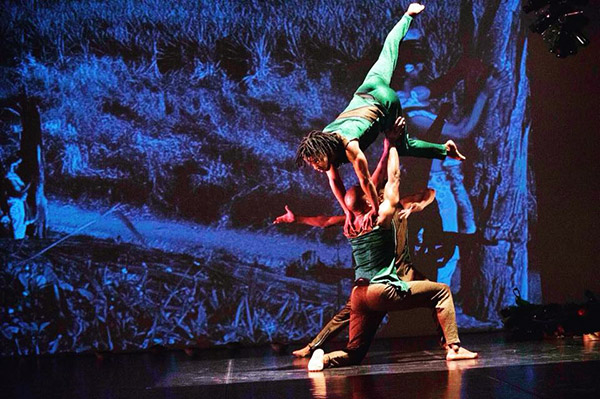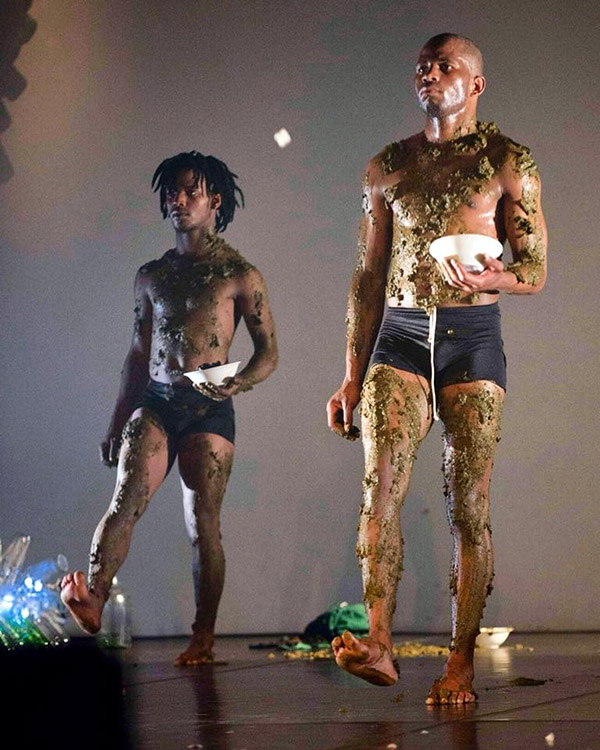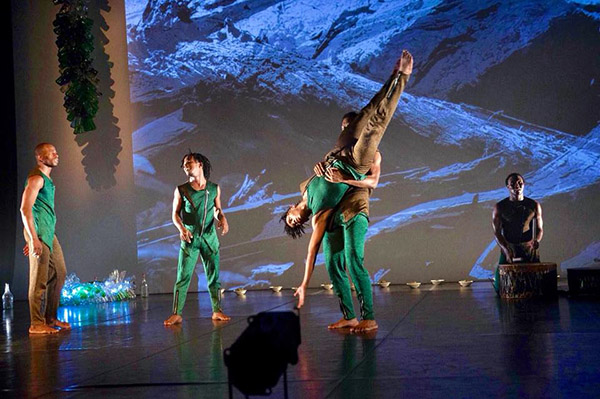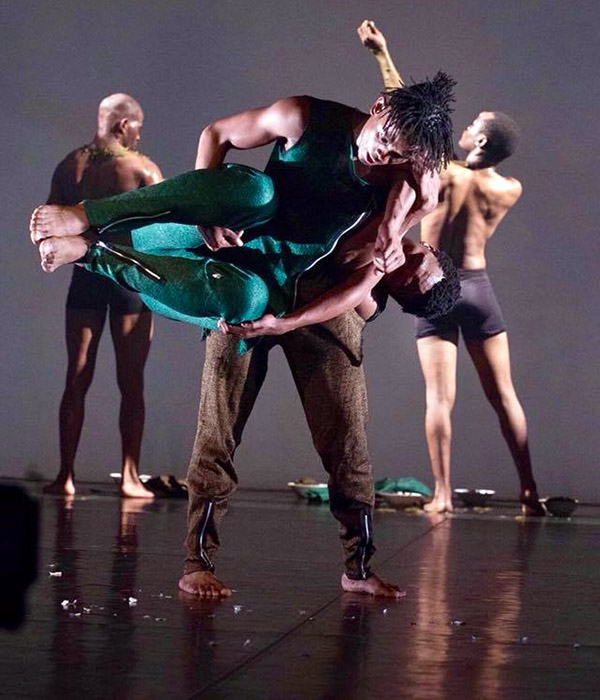A Choreographic Approach to Understanding the Black Male Body
An Interview with Musa Hlatshwayo
Musa Hlatshwayo is a dancer and choreographer in South Africa. One of his most recent works, UDODANA, explores the black male body, its constructed identity and its placement in society. He shares his impetus for making the work, as well as its relevance and impact.
~~
Tell me a little about your history and how you became interested in dance and choreography.
I’ve always been a mover; it all started in my mother’s womb. I was then born into a family comprised of a reverend’s son (my father) and a Sangoma’s daughter (my mother). Both these families used movement and dance often in their daily life. My father and my mother were self-employed and therefore relied on their creativity and acquired skill to earn a living. My mother was a dressmaker and my father was a house builder.
I grew up in a rural area (in Maphumulo) where we were responsible for our own fun and growth in terms of extracurricular activities and physical education. We had no access to any of the things that are now regarded as essential to the development of youth in schools and communities. We had to come up with creative ways of keeping ourselves ‘busy.’ These included sports, different kinds of dance, and community or youth events and activities.
I then came to the University of KwaZulu Natal to register for my BA in Media and Communications where I took performing arts as an extra subject. I was moved by a performance by the then Flatfoot student company. I inquired about the kind of style they were doing and what it took to get in. I attended their next auditions at the beginning of my second year and made it through. That marked the beginning of my training in contemporary dance technique. I moved on to study in Denmark at the Copenhagen Contemporary Dance School through a scholarship I was awarded by an exchange program. I did not apply for it and was not even aware of it. In fact, my lecturer broke the news to me on the day that I had asked to speak to her – to tell her that I was quitting as I felt that I was struggling. Being told about this opportunity changed everything. I returned to study the politics of performance and community intervention and alternative education through the arts. I was then approached by Lliane Loots to be one of the founding company members of Flatfoot Dance Company, and the rest is history.
How did you become interested in crafting choreography that fosters dialogue across socio-political barriers?
I suppose what drew me to the arts, and specifically dance, is the poetic nature of the artform and the impact it has. In fact, that which we cannot articulate easily through oral communication forms the base of that which I then create work about. I realized I could address through dance subject matters that I might not be well-versed in addressing verbally because of boundaries set by culture, religion and tradition.
Your recent piece at the National Arts Festival, UDODANA, is described as an exploration of the black male body, its constructed identity, and its placement in society. Why this piece, and why now?
UDODANA, the word itself, is a poetic reference given to a collective of young males who serve a specific religious, cultural or traditional organization. It can be translated to ‘the sons’, ‘the princes’ or ‘the heirs.’
This work was important for me to create as it is an externalization of many questions. We are going through a phase of a massive femicide and gender-based violence in KwaZulu Natal where men seem to find ease in imposing their brokenness by inflicting a lot of pain upon women and children. We are seeing a lot of cases of domestic violence, rape and anger projected towards women and children by men who still stand tall and find ways to justify their actions by blaming the very same people they victimize as they themselves turn around to play victims.
This piece was therefore born out of my personal introspection about what it means to be a black man these days, what influence our upbringing and socialization has on who we are, the performative cries that we project out as misguided masculinities and, ultimately, our brokenness. It was also born out of a need for me to address some personal issues about my own upbringing and my relationship with my father, the land and the communities that I am constantly negotiating my existence with.
Can you tell me about the construction and formation of the piece? What movements and structures were you exploring to get across your ideas?
Aesthetically, UDODANA is a multi-disciplinary, all-male ensemble piece featuring live traditional drumming accompanying a creative fusion of deconstructed styles of dance whose influence is under the Zulu tradition. I decided to dissect these styles. We worked a lot with improvisation in the quest to discover organic movement, cultural symbolism, imagery and soundscapes that would best create this world we wanted to place our characters in and journey our audiences through. We also interrogated the oral language largely associated with men and rites of passage by chants, songs and spoken word.
I chose to work with video as I was particularly interested in building a visual landscape that captures the beautiful valleys and hills where I grew up around Maphumulo. The images of the characters discovering and rediscovering broken down or rotten trees that they would ‘pray upon’ and eventually dismantle is one symbolic image used in the videography. 100 white arum lillies form part of the piece, providing a scent as an addition to the elements that seek to activate all the senses, as well as a reference to a real-life story of how I collected 100 white arum lilies and placed them around my father’s coffin on the day of his funeral. I also use a recording by the infamous Mr. Julius Malema as he talks about race and land politics in South Africa.
The process of working towards presenting UDODANA was exciting, challenging and eye-opening. I needed to dream (literally) and get close to my own truth while receiving more clarity on my artistic intent with the piece and its flow. Slowly but surely, things happened and UDODANA finally premiered at the National Arts Festival 2018 at the Rhodes Theatre from the 6th until the 8th of July. We have just staged it at the Jomba! Contemporary Dance Experience in Durban; yet again, to a massive standing ovation.
What kinds of responses did you receive to UDODANA?
UDODANA has been performed to standing ovations from the very first performance to the latest one. It seems to be sparking a lot of emotion across races, genders, even ages. The following are some quotes:
” I am still trying to find the best fitting words to express the emotions I felt yesterday as I was watching UDODANA… it was an out of this continent experience… from costumes to choreography to drummers to vocals and OMG the dancers were on point… outstanding. I held my tears back… too beautiful.” -Pinkie Mtshali, jazz and classics singer, Durban
“I thought of Shakespeare’s line, ‘What a piece of work is man, how noble in reason, how infinite in faculty, in form and moving how express and admirable’ when I saw this profound and extraordinary art. The word genius came to mind, because holding that wide, deep range of creative endeavors with perfect technicality takes nothing short of that. Salute, Musa.” -Gisele Turner, theatre maker and arts reviewing columnist, Durban
Do you think the reception and understanding of your work is unique to South Africa, or do you think it might be enlightening and relevant in other areas of the world as well?
I would like to think that the subject matter of patriarchy and these performative masculinities is a global issue. The rule of men and the systems that potentially contribute to our conflicted identities is an issue across race and culture. It is amplified among black men because of the role of other systems that have had their toll in our political history. While it might be seen as largely representative of the struggle of black men in Africa and America, patriarchy and the quest for (definitions and corrections of) a ‘sensible’ masculinity is a global issue.
In her review, Lauren Warnecke beautifully summarizes, “Hlatshwayo’s exploration of his black male identity joins an overarching investigation of masculinity at this year’s Jomba!; he opens a window to his own struggle with affirming his place in the world and coping within a society that continues to permit toxic masculinity. In so doing, he wrestles with larger socio-political themes such as land rights (evidenced through his use of a divisive speech by Julius Malema) and Zulu traditions which locate his work firmly in South Africa, but, most certainly, UDODANA resonates across cultures and lands.”
In general, do you think there’s a uniquely South African voice in choreography?
Yes and no. Given the nature of our political history and the landscape of our current socio-politics, a South African choreographic voice will always change according to the context and placement of the choreographer. We are a very diverse society with highly diverse ways of dealing with similar experiences. That is largely influenced by how even in our sameness, we have always been divided by various kinds of political systems.
Given the context and content, South African work might always come across as politically charged with various issues and agendas. Our politics of presentation and representation will always add to the political nuances of the work. Depending on which lens you view the work from, it might come as across as too much and redundant, or necessary.
Any future projects or other ideas you want to explore that might have come out of UDODANA?
The plan is to continue creating work that is socio-politically engaging, the kind that continues to expose more questions and other perspectives. I believe that through this kind of curiosity, I will continue to evolve as a creative and as a citizen of this beautiful country. Since staging UDODANA, I have also created another work called NDONI. This was simply a tribute to the women of KwaZulu Natal who migrate from the rural areas to the city to become what we call fruit and vegetable street vendors at the market.
~~
Musa Hlatshwayo has a BA in Performance Studies from the University of KwaZulu Natal and a Dance and Choreography diploma from the Copenhagen Contemporary Dance School. He founded Mhayise Productions, the company under which he conducts much of his own work. He also initiated the Movement Laboratory, a development program that offers free training to young artists and the arts community in and around Durban, South Africa. In addition to his own work, he has performed with Flatfoot Dance Company (where he began his dance training), Fantastic Flying Fish Dance Company, Moving Hands Theatre Company and the Birmingham Repertory Theatre in the UK.
Pictures by Val Adamson courtesy of Jomba! Contemporary Dance Experience





2 Responses to “A Choreographic Approach to Understanding the Black Male Body”
Thanks Misa!!
What a GREAT read! I love how this blog is creating a global perspective on dance. Brave work!
Comments are closed.